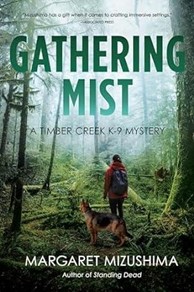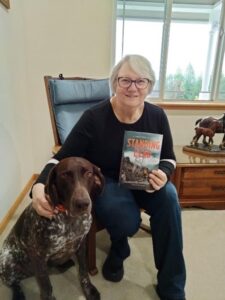 I recently returned home from Left Coast Crime (LCC) in Denver, a well-organized and delightful conference that occurs annually in different cities in the western region of the United States. Readers and authors mingle and get to learn about new books. If you love crime fiction, I highly recommend attending. Next year we’re headed to San Francisco, and I’m already excited. The website is up, so check it out here.
I recently returned home from Left Coast Crime (LCC) in Denver, a well-organized and delightful conference that occurs annually in different cities in the western region of the United States. Readers and authors mingle and get to learn about new books. If you love crime fiction, I highly recommend attending. Next year we’re headed to San Francisco, and I’m already excited. The website is up, so check it out here.
At LCC, authors are assigned to topic-related panels to discuss their books, and mine was titled Working Dogs. What fun! Moderated by C. B. Wilson, authors Kathleen Donnelly, Jodi Burnett, Sheri Lewis Wohl, and I discussed the working dogs we’ve created for each of our mystery series. Donnelly’s books include a national forest service K-9, Burnett’s an FBI K-9, and Wohl’s a human remains detection dog (HRD). Mine is a patrol and narcotics detection K-9 in a Colorado high country sheriff’s department.
When creating a dog character, the author must first decide the role that dog will play in the story. If you write cozies, the dog might play a number of roles, including companion animal, therapy dog, comic relief, or psychic partner, among others. The dog could be any breed, a mix, but the cuter and quirkier the better.
If you portray a working dog, the job requirements might dictate the breed you select. I said “might” because nothing is cut and dried in fiction and, in this case, real life too. Although police departments use a large percentage of high prey-drive breeds such as Belgian Malinois, German shepherd, and Dutch shepherd, it’s not unheard of to use Giant Schnauzers, Labrador retrievers, and even German shorthair pointers for specific duties such as detecting drugs, explosives, smuggled plants, animals, guns, or other goods.
Once you’ve selected the breed of dog, research it thoroughly. It helps if your chosen breed of dog is, or once was, a part of your family. If not, interview people who have knowledge about living with the breed you chose. Discover their unique behaviors, body language, and natural abilities. Find out how trainable they are, whether or not they are typically treat/food driven, and if they’re independent-minded or want to please their handlers.
The dog in my Timber Creek K-9 Mysteries is a German shepherd named Robo. Two of the police K-9 handler/trainer consultants for my series worked with this breed and told me amazing stories of their dogs’ skill sets and accomplishments. Both let me shadow them while they trained dogs and rookie handlers how to track and apprehend (a euphemism for “bite and hold”) fugitives and detect and indicate drugs and evidence. I researched online and in books about the many skills a police dog can acquire, as well as their variety in temperament and socialization, ranging from “land shark” (a dog that can’t be trusted around children and civilians) to a “pussycat” (one that is a family dog when off duty). I attended regional police dog trials, competitions in which police dogs perform skills, agility, obedience, and apprehension, and compete to win the honor of “Top Dog.”
Once you have a good concept for how your dog character should behave and perform, decide what character arc your dog should have. Like character arcs for humans, fictional dogs must have them too. The police duo in my series is Deputy Mattie Cobb of the Timber Creek County Sheriff’s Department in Colorado and her German shepherd partner Robo, a newly minted team serving in the first K-9 unit for their county. Timber Creek ranchers and merchants purchased Robo to fight drug trafficking through their mountain community. Not only is Mattie beholden to her community for the opportunity to handle the first K-9 in their jurisdiction, she must also prove to her colleagues that she’s up for the job.
Mattie and Robo must perform well, or she’ll lose her chance to be Robo’s partner to another deputy on their force. Robo’s trainer has told Mattie she has to learn to trust and listen to Robo, or they’ll never be any better than a single human officer can be; but if she’ll let him do his job, they can be the best K-9 team in the region. This sets goals for the series and a character arc that can span several books.
Some dog books are written in the dog’s point of view, some in both dog and human characters’ POV, and some in only the human’s. I chose the latter, but there are popular stand-alone books and series written in both of the former. Choose your POV and start writing. Work your dog’s behavior into the action to show its personality as well as the portrayal of the animal-human bond between characters. Make your dog an integral part of the story; don’t make them just sit in the car. Let them grow along with your human protagonist. Give your working dog something to do that is vital to solving the case.
Readers fall in love with animal characters in books. The number of working dog novels available has increased over the years. If you create an animal character, have fun with it. You’ll soon learn they’ll leap from the page and become a part of your lives, both as readers and writers. I’m always looking for new ways to challenge Robo and Mattie. I consider them both a part of my family.
I invite you to meet my crime-solving duo and enjoy their latest adventure, Gathering Mist. Each of the nine Timber Creek K-9 Mysteries stands alone, but if you enjoy starting with book one in a series, it’s Killing Trail. For more details, visit my website: https://margaretmizushima.com/.

Margaret Mizushima writes the internationally published Timber Creek K-9 Mysteries. She served as a past president of the Rocky Mountain Chapter of Mystery Writers of America and was elected Writer of the Year by Rocky Mountain Fiction Writers. She’s the recipient of a Colorado Authors League Award, a Benjamin Franklin Book Award, a CIBA CLUE Award, and two Willa Literary Awards by Women Writing the West. Her books have been finalists for a SPUR Award by Western Writers of America, a Killer Nashville Silver Falchion Award, and the Colorado Book Award. She and her husband recently moved from Colorado, where they raised two daughters and a multitude of animals, to a home in the Pacific Northwest. Find her on Facebook, X, Instagram, and her website.
